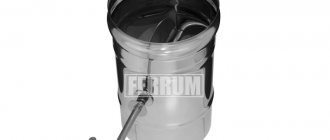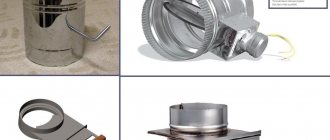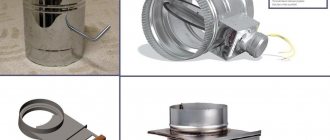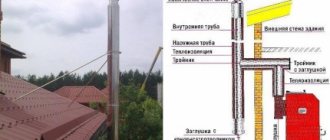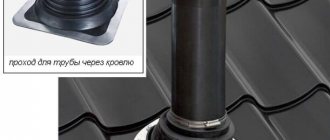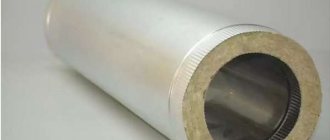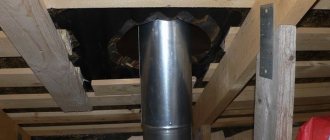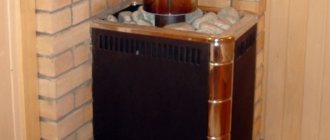Here you will learn:
- What is a gate valve
- Functions, purpose and characteristics
- Main types of gate valves
- Making a gate valve with your own hands
- Tips for choosing a gate valve
- Installation features
- Gate maintenance
Do-it-yourself chimney damper - the drawings of this device are very simple. The gate can be made of a retractable or throttle type. The material for making the gate is cast iron or steel.
What is a gate valve
The German word Schieber in Russian has not changed either its pronunciation or meaning. If we talk specifically about stove heating, then a damper, as well as a damper, is a shut-off device that blocks the chimney channel.
When arranging a smoke exhaust duct, a valve is installed in the upper part of the base, which is located in the room, so that, if necessary, it is possible to manually regulate the movement of gases, and at the same time the quality of draft.
This is what the gate looks like when extended. When retracted (when the stove is already heated), the valve is almost invisible, only its “eye” protrudes outward.
A damper on the chimney duct is required for the traditional version of a brick stove. By retracting it partially or completely, you can reduce the draft or block the movement of heated gases.
The damper is fully retracted when the stove is heated and gases harmful to health stop flowing into the channel. There are known cases of deaths of people who were burned by a stove that was “closed” early.
If you are late in closing the damper, the heat from the heated bricks will go into the pipe, and the temperature in the room will quickly drop. A timely retracted damper is a guarantee that the house will be warm for at least a day. As you know, in village houses during the cold season the stove has to be lit every morning.
Factory-produced steel gate valve with a diameter of 200 mm. To simplify installation, it is sold together with a piece of steel pipe, built-in.
There is an opinion that dampers, which are mandatory for brick stoves, are absolutely not needed for steel stoves (although they are offered by manufacturers), as well as for models with an installed deflector.
The argument against their use is the fact that the chimney quickly becomes clogged with soot when the damper is closed. Its upper part is cooled by cold air entering the pipe, which, when in contact with a hot steel pipe, forms a large amount of condensate. This situation requires more frequent chimney cleaning.
Functions, purpose and characteristics
The damper is a partition that is located inside the chimney. It follows the shape and area of its cross-section and, when closed, almost completely covers it. Changing the position of the damper allows you to increase or decrease the opening of the chimney pipe, increasing or decreasing the air flow. Using the damper, you can stop the movement of air after lighting the stove.
The gate valve is a thin metal plate that is manually adjusted using a special handle. The latter is located outside the chimney pipe so that the user can manually adjust the position of the plate.
Depending on the design and type of damper, it is installed using a special metal frame, or is inserted inside the pipe and fixed with an axial rod.
Important! Do not assume that the valve completely seals the pipe in the “closed” position. According to fire safety requirements, the damper must have a small hole through which weak gas exchange occurs.
The damper in the chimney performs the following functions:
- increases traction force in difficult weather conditions;
- increases the intensity of combustion in the furnace due to increased oxygen flow;
- reduces draft when there is a strong hum in the chimney during strong winds;
- saves fuel by reducing combustion intensity;
- prevents heat loss after the heater has warmed up.
Very important! You can close the chimney with a damper only after the wood has completely burned and the flame has gone out. If you close the damper prematurely, this can lead to a dangerous situation due to the release of large amounts of carbon monoxide into the room. If the damper is closed too late, the efficiency of the furnace will be reduced, because Most of the heat will go out through the chimney.
How to make a stove valve with your own hands?
Do-it-yourself stove chimney valve is not a problem. At home, having a grinder, a welding machine and the necessary material, you can assemble both a retractable and a throttle gate. It is very important in such a matter to maintain the accuracy of calculations. It is necessary that the valve fits perfectly into the groove and can move freely there.
Retractable gate
There is nothing complicated here. The retractable gate is a retractable frame and the base itself.
- The chimney damper for a stove with a sliding frame requires the most accurate measurements. First you need to calculate the cross section inside the pipe.
- Next, based on these measurements, a frame is cut out (most often a steel sheet is taken) that will extend. A bend is made at its end for more convenient control. All ends should be carefully cleaned so that there are no unnecessary irregularities.
- Depending on the chimney, a steel sheet, strip or wire is used for the frame. But there is a method for a round chimney. Use two identical sheets of metal (thickness - 2 mm) and cut two holes in the middle according to the diameter of the pipe. The plate that will fit into the frame is cut out separately.
- Next, you need to weld the structure so that the holes for the pipe match. Between the sheets you need to leave 4-6 mm of free space.
Video instructions for making a retractable stove valve for a metal chimney:
Manufacturing of a rotary gate
For a rotary valve you will need a steel angle (30 by 30) and sheet steel 2 meters thick.
- First, measure the chimney and make a frame from the corner using these measurements.
- We cut out the part according to the measurements and try it on the pipe.
- We take a piece of pipe with internal thread and place it in the center of the workpiece. We make marks so that the edges of the pipe are 3 mm shorter than the valve itself.
- Cut off all excess.
- We make 3 holes on the valve blank and weld the pipe to them.
- The structure is ready (the installation process is described below (after the brick version).
A homemade valve in a chimney has a right to exist. The only thing is that this matter can take a lot of time due to the number of precise measurements.
Useful video instructions for making a rotary gate:
Main types of gate valves
- Horizontal retractable gate. The plate located inside the damper extends, due to which the cross-sectional area of the chimney is adjusted. Typically, this type of valve is used for installation in brick chimneys. Often small holes are made on the surface of the plate so that even in the closed position of the gate, it does not block the smoke channel 100%. This complies with fire safety regulations. The advantage of this type of device is ease of installation.
- Rotary gate. It is also called a “throttle valve”, which is a metal plate mounted on a rotating axis. The axis, in turn, is attached inside the chimney pipe. This device has a removable rotating disk, but with prolonged use it may become unusable. However, the design of the rotating mechanism allows you to repair and replace it yourself. The advantage of this type of device is its ease of operation. This type of gate does not require constant monitoring by the home owner.
Due to the complexity of the DIY design, the rotating mechanism is less often used when laying a fireplace or stove.
The gate design is necessary for wood-burning stoves and heating devices operating on any solid fuel.
As for gas boilers and liquid fuel boilers, here the damper rather plays the role of protecting the chimney from precipitation.
Therefore, for a gas boiler, the most practical solution would be to install a rotary mechanism. The temperature of the exhaust gases is less low than when using solid fuel, so the operation of such a mechanism will be the most convenient.
Valve on an insulated chimney
But it is better to refuse to install a rotary mechanism in the bathhouse. The fact is that it will partially allow steam to pass through when closed. And when open, such a mechanism is difficult to clean.
Made of stainless steel, the gate mechanism will not completely block the chimney, but will eliminate the possibility of flames escaping through the ash pan into the room.
There are three options for installing the gate.
- Installing a damper in a fireplace insert. To do this, the damper is mounted at a distance of 1 meter from the heating device, which ensures simple operation.
- The “pipe to pipe” option involves combining the damper with other elements of the heating structure without the additional use of fasteners.
- Installation of a gate valve in a ventilation pipe. But this option is usually used to protect the fan motor from overheating during operation.
When purchasing ready-made chimneys, the kit will most likely be equipped with a gate valve, which simply needs to be installed according to the instructions.
But even if the finished kit does not come with this element, you can easily make the gate yourself by choosing the most optimal mechanism option for yourself.
Advantages and disadvantages
Like any engineering solution, a gate has a number of advantages and disadvantages.
Pros:
- Possibility of traction control;
- Fuel economy;
- Dampers help retain heat.
Minuses:
- The devices make it difficult to clean chimneys;
- If installed incorrectly, the gate may jam and negatively affect the movement of gases;
- To make the correct adjustment, you must have some knowledge in the field of smoke exhaust systems.
Differences between retractable and rotary gates
The retractable damper allows you to adjust the working cross-section of the chimney, while the rotary damper only allows you to open or close the pipe. Of course, some tricks are possible - such as securing the hog in an intermediate position in different ways, but the factory equipment does not provide for this. In addition, the rotary gate complicates mechanical cleaning of the pipe.
The hog is often installed in metal chimneys, and the retractable one is installed in brick chimneys.
Home manufacturing technology
Qualified specialists always emphasize that even a novice craftsman can make a rotary and retractable gate. After all, in order for the finished product to perfectly cope with its main task, you need to correctly take all the necessary measurements. If the finished damper fits tightly into the chimney, then over time it may jam, as it will be exposed to high temperature. And when there is a large gap between the valve and the pipe, it will be difficult to regulate the intensity of the draft during operation.
Multifunctional butterfly valve
To make this type of gate, you need to use a steel angle of 30x30 mm, as well as durable sheet steel, the thickness of which is at least 1.5 millimeters. The manufacturing process itself consists of several main stages, which must be implemented in strict sequence:
- Initially, you need to take measurements of the inside of the chimney. This is done in order to avoid mistakes during the manufacture of a frame from a corner, which is fixed with a welding machine.
- On one side of the frame, exactly in the center, you need to drill a small hole (7-8 mm in diameter). It will be useful for the rotary axis.
- A similar hole must be made on the other side of the frame.
- The plate for the damper must be cut from a steel sheet. This part must fully correspond to the internal dimensions of the manufactured frame.
- To make a guide axis, you need to take a piece of wire with a diameter of 9 mm and a length that will exceed the size of the frame itself by 7 cm. You need to cut a thread on one side of the wire (a die is best for this task).
- The finished axle is carefully threaded into the holes on the frame and secured with a nut.
- All cuts on the plate are processed with a grinding machine and inserted into the frame.
- At this stage, the master must weld the axle exactly in the center of the plate.
- All that remains is to make a comfortable handle for the guide from high-quality scrap materials.
Experts always use one piece of advice that prevents the rotary axle from loosening: you need to insert small bushings cut from an ordinary metal pipe into the holes.
Universal device
Modern gate valves include the valve itself, as well as a special guide frame. That is why, before starting work, the master must measure the internal cross-section of the pipe or brick chimney. In accordance with the available measurements, a neat rectangle is cut out of sheet steel (5 mm thick). A small longitudinal fold is made on one side, the width of which should not exceed 30 mm.
These manipulations are necessary so that the finished damper can be conveniently pulled out. Each cut must be polished, due to which the dimensions of the product are reduced by 2 mm on each side. Such actions by the technician will ensure free movement of the damper inside the chimney.
When the damper is made for a brick fireplace, the frame itself can be made of thick steel wire, the diameter of which is within 6 mm. During this procedure, the metal blank is simply bent into the shape of the letter P in strict accordance with the existing measurements.
If the chimney has a rectangular shape and is made of steel, then it is better to make the frame from a metal strip 2 mm thick and up to 35 mm wide. The prepared strip is bent lengthwise, leaving a neat gap along the thickness of the plate. Only after this can small cuts be made in two places at an angle of 45° to give the workpiece a U-shape. All gaps in the places of cuts must be butt welded.
To connect the ends of a homemade damper, you need to use two pieces of metal, which should be positioned in such a way that the damper blade can pass freely between them. At the end of all these manipulations, the master should come out with a rectangular frame with grooves for the shutter.
To make a valve in a round pipe, you need to take two identical metal sheets 2 mm thick. Round holes are cut in the center in accordance with the diameter of the chimney. The valve plate must be manufactured separately. After this, the sheets are connected to each other using a welding machine.
It is necessary to weld only three sides around the perimeter so that the holes of the finished valve on the pipe match exactly. A gap of 5 mm must be left between the top and bottom sheets. At this point, the damper manufacturing process can be considered complete, since the craftsman can only insert the valve and secure the finished product to the chimney.
Making a gate valve with your own hands
Gate drawing
Both a retractable and a rotary gate can be made independently if you have a welding machine and a grinder. Assembling both structures is not difficult, the main thing here is the accuracy of the measurements. If the valve fits too tightly into the pipe, it may jam when exposed to high temperatures. If you leave a large gap between the plate and the pipe, this will make it difficult to adjust the draft.
Manufacturing of a retractable gate
Retractable gate
The design of the gate consists of the valve itself and the guide frame. First you need to measure the internal cross-section of the pipe or brick chimney. According to measurements, a rectangular valve is cut out of sheet steel 4-5 mm thick. On one side, a longitudinal fold 20-30 mm wide is made to make it easier to pull out the flap. All cuts are carefully polished, simultaneously reducing the size of the product by 1-2 mm on each side. This will ensure free movement of the damper inside the chimney.
If the damper is installed in a brick chimney, the frame can be made of thick steel wire, for example, with a diameter of 6 mm. To do this, the wire is simply bent in a U shape to fit the hole.
Gate diagram
If the chimney is steel and has a rectangular shape, the frame is made of a steel strip 2 mm thick and 30-35 mm wide. The strip is bent lengthwise, leaving a gap along the thickness of the plate, then cut in two places at an angle of 45 degrees and given a U-shape. The gaps in the places of the cuts are butt welded. The ends of the homemade profile are connected with two pieces of metal, positioned so that the valve blade passes freely between them. You should get a rectangular frame with grooves for the gate. In this case, the internal perimeter of the frame must be equal to the cross-section of the chimney.
Manufacturing of gate valves
Ready-made damper design for a round chimney
For a round chimney, the damper is made a little differently: take 2 identical metal sheets 2 mm thick, cut round holes in the center according to the diameter of the pipe, and cut out the valve plate separately.
Now the sheets need to be connected by welding on three sides around the perimeter so that the holes for the pipe coincide, and there is a gap of 4-5 mm between the top and bottom sheets. After this, all that remains is to insert the valve and secure the gate to the pipe.
Instructions for making a throttle valve
Making a butterfly valve requires more tools and time. Most often this type of damper is used for metal chimneys for modern fireplaces and metal freestanding stoves.
Set of tools for work:
- Bulgarian;
- drill;
- pliers;
- welding machine;
- compass;
- roulette;
- marker for marking.
To make a gate, you need sheet steel up to 3 mm thick, a stainless steel pipe with an internal diameter of 6 mm, fasteners (bolts, nuts) 8 mm, and a metal rod.
- First, measure the internal diameter of the chimney pipe using a compass.
- According to it, draw a circle on sheet steel.
- Use a grinder to cut out a circle.
- Place the cut fragment into the pipe and check the tightness of the fit. If necessary, rework the valve with a grinding disc.
- Place a metal tube with a diameter of 6 cm on the circle in the center and make marks on it, retreating 3 mm from each side of the circle.
- Cut off the tube with a grinder.
- In the resulting pipe section, drill the threads to 6.8 mm on both sides.
- Drill holes in the steel circle for welding (one in the center, two 1 cm from the edge on opposite sides).
- Weld the threaded tube to the steel circle.
The slide valve is ready, all that remains is to install it in the chimney pipe.
Making and installing a gate valve with your own hands
Required materials and tools
To independently manufacture and install any type of stainless steel gate, we will need the following tools:
- Bulgarian;
- Abrasive wheels - cutting and grinding;
- Drill;
- Tap and thread lubricant;
- Hammer;
- Pliers;
- Vise;
- Welding and electrodes;
- Kern;
- Roulette;
- Compass;
- Marker.
And materials:
- Stainless steel sheet (preferably domestic brand 12×18n10t, or imported AISI304, they are more expensive, but last an order of magnitude longer).
Sheet thickness 1.5-2.5mm;
- Stainless steel tube 6mm;
- Bolts 8mm -2 pcs;
- Metal rod for the frame.
Drawing and diagrams
Before manufacturing, it is necessary to draw a drawing or diagram of the future valve.
I will give some example diagrams below:
Size calculation
You need to take measurements very carefully; a gap of even a few millimeters can cause the chimney to malfunction.
Actions step by step:
- Using a tape measure, measure the dimensions of the internal section of the channel;
- Add 20-30 mm to the obtained result - you get the outer size of the frame;
- Do not forget to make an opening in the finished valve to release gas;
- The position of the welding holes should be accurately marked.
We summarize the dimensions for the rotary gate in the table:
Tips for choosing a gate valve
It must be remembered that the correct selection of an element such as a slide damper is reflected in the future not only on the draft indicator, but also on the safety of the heating system, of which the chimney is a part. Installation of the damper is carried out on any model of fireplaces and stoves, except for the most modern ones, which have a deflector.
The main recommendations for choosing slide valves for smoke exhaust communications are as follows:
- If the heating device operates by processing gas, it is better to purchase a rotary valve model. This is due to the fact that such models exclude the possibility of completely blocking the smoke exhaust channel. Thus, the heating system will be safer. The chimney, which removes combustion products from the gas stove, must be closed by at least 40 percent during operation;
- There are heating systems that operate intermittently (periodic). A closed damper installed in such a heating structure, as a rule, allows steam to pass during supply, and an open damper contributes to the formation of a large amount of soot on the pipe, which is located below the plate;
- It is strictly not recommended to use rotating elements for installation in sauna chimneys.
A rotating device is the most suitable option for a gas-consuming system
Note! The chimney damper is a shaped part of the chimney service, so if you purchase everything necessary for laying a chimney, it will be included with the pipes. Such shutters can be purchased at any specialized store or ordered using an online store on the Internet.
Experts recommend carefully measuring the cross-section of the smoke exhaust duct before purchasing a gate product. Perhaps this is the main thing that needs to be done before purchasing a gate.
Installation features
- When installing the gate at the stage of laying brickwork, the frame is placed at a height of 6-8 rows from the base of the pipe;
- The frame should stand straight, without blocking the outline of the chimney;
- In stainless steel chimneys, the valve is installed using the “pipe-to-pipe” technology. It is necessary to coordinate its dimensions with the diameter of the channel;
- An important nuance - the damper is installed on an uninsulated section of the chimney;
- The height from the firebox to the damper should not exceed 1 m (for metal channels);
- Pipe height from the floor to the valve - 1.8 - maximum 2 m (for brick);
- The damper in the grooves should move freely;
Gate maintenance
The gate, made of stainless steel, is usually polished to perfect smoothness. Soot settles on it poorly, but still settles. Therefore, it must be cleaned periodically.
The horizontal valve can be cleaned simply by pulling it out to the maximum and applying a special solution. Rotary - cleaned through the chimney with a special plastic brush. You should also ensure that the damper moves freely along the guides. It is allowed to periodically lubricate them with an anti-corrosion compound.
Features of gate maintenance
The gate, made of stainless steel, is usually polished to perfect smoothness. Soot settles on it poorly, but still settles. Therefore, it must be cleaned periodically.
The horizontal valve can be cleaned simply by pulling it out to the maximum and applying a special solution. Rotary - cleaned through the chimney with a special plastic brush. You should also ensure that the damper moves freely along the guides. It is allowed to periodically lubricate them with an anti-corrosion compound.
